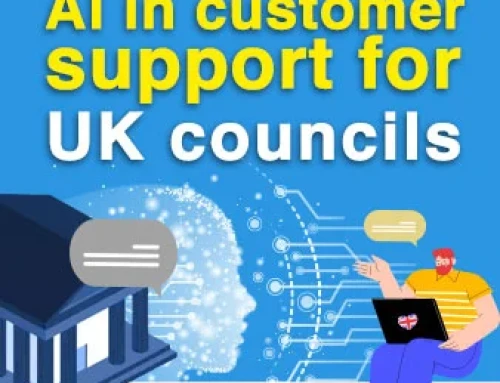From good to great: Elevating service standards in your local authority
A roadmap to service delivery excellence
Local authorities are at the heart of shaping the quality of life for their communities. As expectations continue to rise, efficient and effective services become paramount. “Elevating Service Standards in Your Local Authority” is a guidebook for those committed to transforming their services from good to grand.
This guide gives practical advice on everything from fostering creativity to utilising technology, drawing on examples of effective municipal governments from all around the globe. It presents public officials and community advocates with the tools they need to effect change through case studies, professional guidance, and helpful resources.
Join us on this transformative journey as we explore strategies that can turn ordinary local authorities into champions of public service excellence, making a lasting impact on our communities.
Why is service quality important?
Service quality is crucial for local authorities as it directly influences customer satisfaction and community well-being. Exceptional customer service ensures that constituents’ needs are connected promptly and effectively, fostering trust and credibility.
Through active engagement and solicitation of customer feedback, local authorities can identify areas for improvement, allocate resources wisely, and continually enhance services. Upholding high service quality is a legal and ethical obligation and a testament to an authority’s commitment to its community’s prosperity and satisfaction.
What are customer service standards?
Customer service standards are rigid criteria and requirements that enterprises, including local governments, follow while interacting with their clients or constituents. These requirements serve as a guideline for providing high-quality services and guarantee that clients receive consistent, effective service. Here is a brief overview of customer service standards:
• Consistency: Customer service standards ensure that all interactions with customers, regardless of the channel (in-person, phone, email, online), are uniform and of the same high quality. This consistency helps build trust and reliability.
• Timeliness: Standards dictate response times for inquiries, complaints, or service requests. Timely responses demonstrate respect for customers’ time and needs, enhancing their overall experience.
• Professionalism: Standards often include guidelines for staff behaviour, such as politeness, active listening, and empathy. Maintaining professionalism during interactions is vital for creating a positive impression.
• Accessibility: Local authorities must ensure that their services are accessible to all, including individuals with disabilities or those who speak languages other than the official one. Standards address accessibility through measures like providing translation services and accommodating special needs.
• Accuracy: Accuracy is paramount when providing information or handling customer data. Standards set expectations for accurate responses, documentation, and record-keeping to prevent errors and misinformation.
• Problem resolution: Guidelines for resolving issues and complaints are essential for customer service standards. They outline procedures for addressing customer concerns and escalating matters when necessary, ensuring efficient conflict resolution.
• Feedback and improvement: Effective standards include mechanisms for gathering customer feedback and using it to drive continuous improvement. This loop allows organisations to adapt to changing customer needs and preferences.
• Data security and privacy: In the digital world, it is crucial to protect customer data. Customer service standards often include services for data security and privacy to safeguard sensitive information.
• Training and development: To ensure staff members can meet service standards. It is normal to establish training and development programs. These programs equip employees with the necessary skills and knowledge to provide excellent customer service.
• Monitoring and evaluation: Organisations regularly monitor and evaluate their adherence to customer service standards. It helps identify areas that require improvement and ensures ongoing alignment with customer expectations.
Customer service standards are guidelines that local authorities and other organisations establish to ensure consistent, efficient, and customer-centric service delivery. These standards are essential for building trust, enhancing customer satisfaction, and fostering positive relationships between organisations and their constituents.
How can local authorities sustain prominent levels of service over time?
Maintaining high service quality over time is essential for local governments to sustain citizens’ satisfaction and competitive advantage.
To uphold high service quality in a constantly evolving business landscape. Local authorities must embrace innovation and adapt to changing customer expectations. One key strategy is the establishment of a digital workplace. It entails equipping employees with the necessary digital tools and resources to streamline workflows, enhance communication, and improve collaboration. A digital workplace furnishes employees with the tools to respond to citizens’ questions and issues, ensuring a responsive and citizen-centric approach.
Furthermore, chatbot integration is an asset in maintaining service quality. Chatbots can respond immediately to routine citizen queries and make human agents focus on more complex issues. These AI-powered bots enhance efficiency, offer 24/7 availability, and cater to customer needs across different time zones and schedules.
Incorporating digital process automation is another pivotal step. By automating repetitive tasks and workflows, local authorities can minimise errors, reduce processing times, and ensure consistency in service delivery. It enhances operational efficiency and enables staff to dedicate more time to personalised citizen interactions, further boosting service quality.
Maintaining high service quality in today’s dynamic business environment requires the adoption of digital workplace strategies, the integration of chatbots for efficiency and accessibility, and the implementation of digital process automation to optimise workflows. By embracing these technological advancements, local authorities can continue to meet and exceed citizens’ expectations, ensuring long-term success and loyalty.
How can local authorities measure service quality?
Regular monitoring of service quality is necessary to ensure a local government surpasses citizens’ expectations and improves its offerings. Work can evaluate the success of their customer management initiatives and spot improvement opportunities by using a variety of indicators and approaches.
One fundamental way to measure service quality is through user satisfaction surveys. These surveys collect user’s feedback, allowing local authorities to understand their experiences and perceptions. Analysing responses and identifying patterns can pinpoint strengths and weaknesses in their service delivery and make informed adjustments accordingly.
Net Promoter Score (NPS) is another widely used metric for assessing service quality. It quantifies user loyalty by asking a simple question like “How likely are you to recommend our product/service to a friend or colleague?” Based on responses, categorise users as promoters (loyal), passives (neutral), or detractors (unhappy). A high NPS indicates strong service quality and customer advocacy.
Service level agreements (SLAs) are essential tools for businesses engaged in customer management. By monitoring SLA compliance, organisations can measure their ability to meet commitments regarding response times, issue resolution, and service availability. This metric helps you ensure that customer expectations are not met but consistently exceeded.
Additionally, organisations can utilise Key Performance Indicators (KPIs) tailored to their specific industry and customer management goals. KPIs such as first-response time, resolution time, and customer retention rates provide quantifiable data on service quality and customer satisfaction.
Local authorities can measure service quality effectively through user satisfaction surveys, NPS, SLA compliance monitoring, and industry-specific KPIs. These tools provide valuable insights into the customer experience and empower organisations to enhance their customer management strategies and maintain a competitive edge in today’s dynamic market.
Final thoughts
In the search for excellence, ‘From Good to Great: Elevating Service Standards in Your Local Authority’ is your compass, guiding you towards a brighter future for your community. With actionable insights and real-world examples, this guidebook empowers local authorities to raise service standards and meet the evolving needs of their constituents. Together, let us embark on the journey from good to great, forging powerful connections, building trust, and creating a legacy of exceptional service. Your community deserves nothing less. And this guide will help you deliver nothing short of excellence.
Must read:
- From legacy systems to custom apps: Modernising your IT infrastructure
- Modernising FOI: Technology’s Influence on Information Access
- Harnessing Artificial Intelligence for efficient public service delivery – a practical guide for the local authorities
- How to improve communication and collaboration for remote teams?





